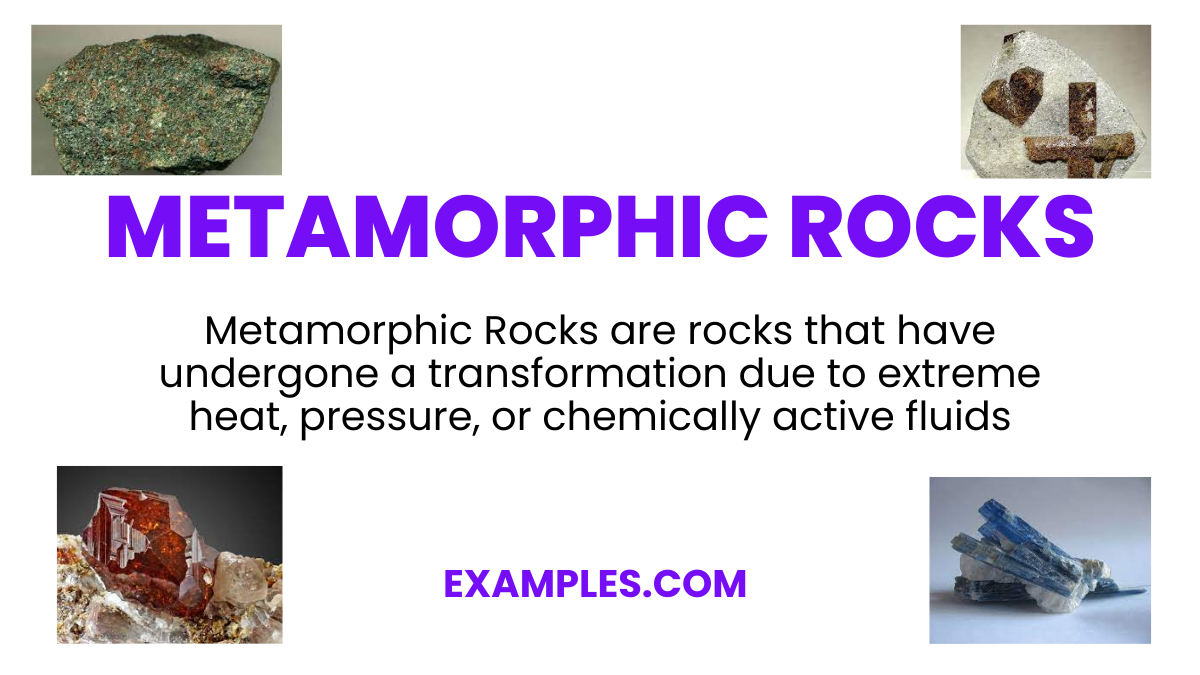Which of the following is a characteristic feature of metamorphic rocks?
Fossil content
Layered texture
Banding or foliation
Vesicular texture

Metamorphic rocks represent Earth’s most dynamic and transformational processes. This comprehensive guide is tailored for educators and students, aiming to demystify the complex world of these rocks. We cover their formation, characteristics, and the roles they play in our planet’s geology. Using practical examples, the guide simplifies the metamorphic processes, making it an excellent resource for classroom discussions. It’s an essential guide for anyone looking to understand the intricacies and wonders of metamorphic rocks.
Metamorphic Rocks are rocks that have undergone a transformation due to extreme heat, pressure, or chemically active fluids. Unlike igneous and sedimentary rocks, metamorphic rocks are shaped by the alteration of existing rock types, resulting in new mineral compositions and structures. This process, known as metamorphism, gives these rocks unique textures and properties. Understanding metamorphic rocks is crucial for students and teachers alike, as they offer valuable insights into Earth’s internal processes.
One of the best examples of metamorphic rocks is Marble. Originating from limestone or dolostone, marble undergoes metamorphism, resulting in its characteristic crystalline structure and often striking veining. It’s valued both for its beauty in sculpture and architecture and for its geological significance. Marble exemplifies the process of metamorphism, demonstrating how heat and pressure can transform rocks into new forms, each with unique qualities and uses. This example is particularly useful in teaching, as it clearly illustrates the concept of metamorphic processes and their results.
Delve into the fascinating world of metamorphic rocks with our comprehensive guide. Ideal for teachers and students, this resource explores 22 unique and distinct metamorphic rocks, showcasing their transformative beauty and geological importance. Each example is explained with its meaning and practical use, enhancing the learning experience. These rocks, formed under the Earth’s surface through intense heat and pressure, reveal the dynamic processes shaping our planet. This guide is a valuable tool for anyone interested in understanding the complexities of Earth’s geology.
Metamorphic rocks are formed through the transformation of existing rocks under intense heat and pressure within the Earth’s crust. This process, known as metamorphism, alters the rock’s mineral composition and structure without melting it. Factors like temperature, pressure, and chemically active fluids play a crucial role in this transformation. The process can take millions of years, resulting in a wide variety of metamorphic rocks, each with unique properties.
Metamorphic rocks are classified based on their formation processes and resulting textures. They can range from foliated rocks, which have a layered appearance, to non-foliated rocks, which lack distinct layering.
Metamorphic rocks exhibit a range of characteristics, influenced by the original rock type and the conditions of metamorphism.
Metamorphic rocks form through the transformation of existing rocks under extreme pressure and temperature conditions, without melting. This metamorphism can occur deep within the Earth’s crust or in areas where tectonic plates collide. The process results in significant changes in mineral composition and structural characteristics. Factors like geothermal heat, tectonic pressure, and fluid activity contribute to this transformation, producing a wide variety of metamorphic rocks.
The process of forming metamorphic rock involves several key steps:
Metamorphic rocks display distinct features due to their formation processes:
Identifying metamorphic rocks involves examining their unique textures, mineral content, and structures formed under high pressure and temperature. These rocks display distinct features that differentiate them from igneous and sedimentary types. Observing these characteristics helps in accurately classifying and understanding their formation process.
Foliated metamorphic rocks are characterized by their layered or banded appearance, resulting from the alignment of mineral grains under directional pressure. This foliation is a key feature in identifying and classifying these rocks. They exhibit a range of textures from fine to coarse, depending on the degree of metamorphism.
Metamorphic rocks, with their profound transformations and distinctive features, play a crucial role in our understanding of Earth’s geological processes. This guide offers teachers and students a clear insight into identifying and appreciating these rocks, emphasizing their significance in the natural world. Embracing this knowledge enhances our comprehension of the dynamic Earth and its ever-evolving landscape.
Text prompt
Add Tone
22 Metamorphic Rocks Examples
Different Types of Metamorphic Rock
Which of the following is a characteristic feature of metamorphic rocks?
Fossil content
Layered texture
Banding or foliation
Vesicular texture
What is the process called that transforms pre-existing rocks into metamorphic rocks?
Melting
Metamorphism
Sedimentation
Weathering
Which of the following rocks is a common example of a foliated metamorphic rock?
Marble
Quartzite
Gneiss
Basalt
Marble is a metamorphic rock that forms from which parent rock?
Limestone
Sandstone
Shale
Granite
Which type of metamorphism is associated with the intense pressure and heat at convergent plate boundaries?
Contact metamorphism
Regional metamorphism
Hydrothermal metamorphism
Burial metamorphism
What is the parent rock of slate?
Granite
Shale
Limestone
Sandstone
Which mineral is commonly found in metamorphic rocks and is used as an index mineral for metamorphic grade?
Calcite
Quartz
Garnet
Halite
Which of the following rocks is non-foliated?
Schist
Gneiss
Slate
Quartzite
Contact metamorphism occurs typically due to which factor?
Tectonic pressure
Heat from a nearby magma intrusion
Burial under sediment layers
Erosion and weathering
Which rock is formed from the metamorphism of shale and has a shiny, foliated texture?
Marble
Schist
Quartzite
Basalt
Before you leave, take our quick quiz to enhance your learning!

